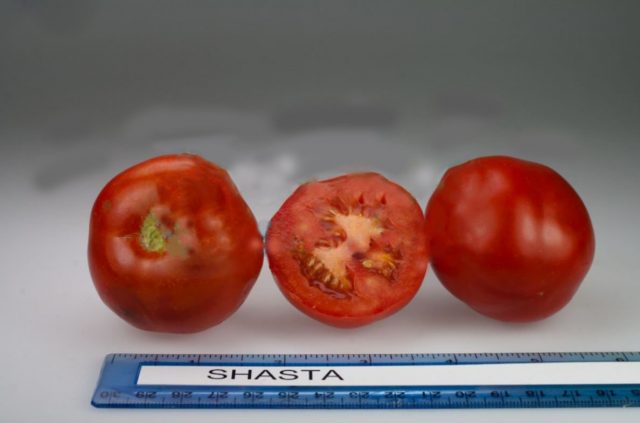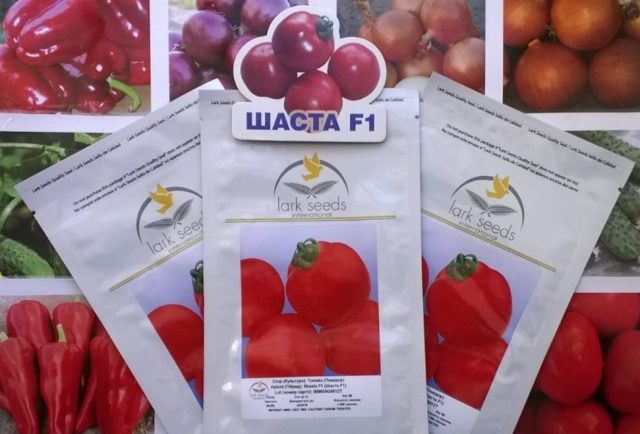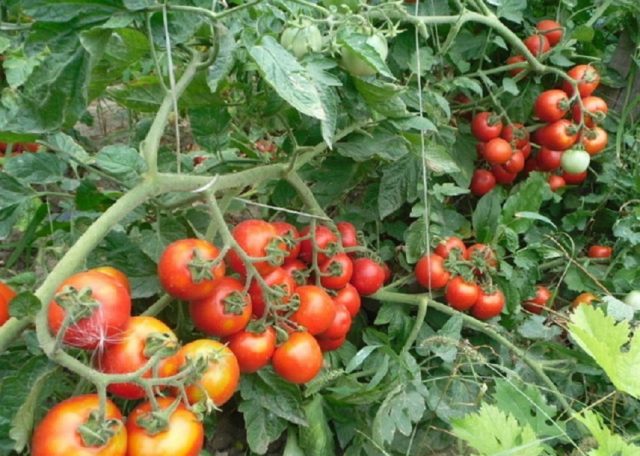Content
Tomato Shasta F1 is the world's earliest highly productive determinant hybrid created by American breeders for commercial use. The originator of the variety is Innova Seeds Co. Due to their ultra-early ripening, excellent taste and marketability, high yield, as well as resistance to many diseases, Shasta F1 tomatoes have also fallen in love with Russian gardeners.
Description of Shasta tomato
Shasta F1 tomatoes are of the determinant type. Such plants stop growing in height when they form at the top of the flower cluster. Determinant tomato varieties are an excellent option for summer residents who want an early and healthy harvest.
In the case of the Shasta F1 tomato variety, when a sufficient number of clusters are formed, growth stops at 80 cm. The bush is powerful, stocky, with a large number of ovaries. Shasta F1 requires a garter to a support, it is simply necessary in case of high yields. The variety is ideal for growing in the fields for industrial purposes. The leaves are large, dark green in color, the inflorescences are simple, the stalk is articulated.
Tomato Shasta F1 has the shortest growing season - only 85-90 days pass from germination to harvest, that is, less than 3 months. Due to the early ripening, Shasta F1 is sown directly into open ground, without using the seedling method. Some summer residents successfully grow Shasta F1 tomatoes in spring greenhouses, forming them as a tall indeterminate. Such agricultural technology significantly saves the deficit of greenhouse area, and the earliest spring tomatoes will be the result of the gardener's labors.
Shasta F1 is a fairly new variety; it was entered in the State Register in 2018. Zoned in the North Caucasus and Lower Volga regions.
Brief description and taste of fruits
Fruits of the Shasta F1 variety have a rounded shape with barely noticeable ribbing, they are smooth and dense. On one cluster, an average of 6-8 tomatoes are formed, almost identical in size. An unripe tomato is green in color with a characteristic dark green spot at the stalk, a ripe tomato has a rich red-scarlet color. The number of seed nests is 2-3 pcs. Fruit weight fluctuates in the range of 40-79 g, most tomatoes weigh 65-70 g. The yield of marketable fruits is up to 88%, ripening is amicable - more than 90% blush at the same time.
Shasta F1 tomatoes have a sweet tomato flavor with a slight pleasant sourness. The dry matter content in the juice is 7.4%, and the sugar content is 4.1%. Shasta tomatoes are ideal for whole-fruit canning - their skins do not crack, and their small size allows you to use almost any container for pickling and salting. Due to their unsurpassed taste, these tomatoes are often consumed fresh, and also prepare tomato juice, pasta, and various sauces.
Varietal characteristics
Tomato Shasta is grown both in large agricultural farms and in private gardens.The fruits have a presentable appearance and good transportability. Shasta F1 is an indispensable variety for the fresh market, especially at the beginning of the season. Shasta tomatoes can be harvested manually or mechanically using a harvester.
The yield of tomato varieties Shasta F1 is quite high. With industrial cultivation in the North Caucasus region, 29.8 tons of marketable fruits can be harvested from 1 hectare, when grown on the Lower Volga - 46.4 tons. The maximum yield according to the statistics of state tests is 91.3 tons per hectare. You can remove 4-5 kg of tomatoes from one bush per season. Reviews about the yield of tomato Shasta F1 with photos illustrating a huge number of ovaries appear with enviable regularity.
Several factors affect crop yield:
- seed quality;
- proper preparation and sowing of seeds;
- strict selection of seedlings;
- soil quality and composition;
- the frequency of fertilization;
- correct watering;
- hilling, loosening and mulching;
- pinching and removing excess leaves.
Shasta F1 has no equal ripening terms. It takes only 90 days from pecking the first sprouts to ripe bulk tomatoes. The harvest ripens together, the variety is suitable for rare harvests. It tolerates hot weather well, but requires regular watering.
Tomato Shasta F1 is resistant to verticillium, cladosporium and fusarium, it can be affected by the black leg. In case of infection with fungal diseases, the diseased bush is dug up and burned, the rest of the plantings are treated with a fungicide solution. Among the most common pests of tomatoes are:
- whitefly;
- naked slugs;
- spider mite;
- Colorado beetle.
Pros and cons of the variety
Among the indisputable advantages of Shasta F1 tomatoes over other varieties, the following can be distinguished:
- early and friendly ripening of fruits;
- high productivity;
- more than 88% of marketable fruits;
- long fresh shelf life;
- good transportability;
- dessert, sweet taste with slight sourness;
- the peel does not burst during heat treatment;
- suitable for whole canning;
- tolerates heat well;
- the variety is resistant to the main diseases of the nightshade;
- the ability to grow in the fields;
- high profitability.
Among the shortcomings, it is worth noting:
- the need for timely watering;
- the possibility of infection with a black leg;
- harvested seeds do not transfer the properties of the mother plant.
Planting and care rules
Due to the short growing season, Shasta F1 tomatoes in most cases are sown immediately to a permanent place, without the stage of growing seedlings. In the garden, recesses are made at a distance of 50 cm from each other, several seeds are thrown, covered with soil and covered with a film until the first shoots appear. The timing of planting Shasta tomatoes varies depending on the region, you need to focus on the temperature regime: 20-24 ° С - during the day, 16 ° С - at night. To improve the quality of the fruits, organic fertilizers are introduced into the soil in advance of sowing.
The first thinning of tomatoes is done when 2-3 leaves are formed in the seedlings. Leave the strongest, the distance between neighboring plants is 5-10 cm. The second time the tomatoes are thinned out at the stage of 5 leaf formation, the distance increases to 12-15 cm.
At the last thinning, excess bushes are carefully dug out with a clod of earth, if desired, they can be transplanted to a place where the seedlings were weak. After transplantation, tomatoes are spilled with Heteroauxin or Kornevin solution, or sprayed with HB-101 (1 drop per 1 liter of water). This will reduce the stress caused by the transplant.
Sowing seeds for seedlings
Sowing Shasta F1 tomatoes directly into the ground is good only for the southern regions. In the middle lane, you cannot do without seedlings. Tomato seeds are sown in low containers with nutritious universal soil or a mixture of sand and peat (1: 1). It is not necessary to pre-disinfect and soak the planting material, the corresponding processing is carried out at the manufacturer's plant. The containers are covered with foil and placed in a warm place with an average temperature of 23 ° C.
In the stage of formation of the 2-3rd leaf, tomato seedlings dive into separate pots and begin to harden, taking them out into the fresh air. Caring for young tomatoes includes regular watering and feeding. Also, the container with tomato seedlings must be turned relative to the light source, otherwise the plants will stretch out and be one-sided.
Transplanting seedlings
Tomatoes of the Shasta F1 variety, like other varieties, are planted in open ground when a warm average daily temperature is established. The distance between neighboring plants is 40-50 cm, at least 30 cm. Each bush is carefully removed from the pot, trying not to damage the root system, placed in a previously dug hole and sprinkled with soil. Plantings are watered with warm water and mulched.
Planting care
To prevent pests and diseases, planting tomatoes is regularly weeded from weeds, mulch and loosen the soil. This improves oxygen access to the roots and has a beneficial effect on the growth and development of the tomato bush, and, therefore, on productivity. Watering Shasta tomatoes is carried out as the soil dries.
Shasta F1 hybrid does not require removal of stepchildren and extra leaves. As it grows, each plant is tied to an individual support so that the stem does not break under the weight of the fruit.
Throughout the growing season, tomatoes must be fed regularly. A solution of mullein, urea, and chicken droppings are used as fertilizers.
Conclusion
Tomato Shasta F1 is a new decent variety with an early fruiting period. Bred for commercial cultivation, it fully justifies its description - it ripens together, most of the tomatoes are of a marketable type, grows well in the field. Shasta is also suitable for private household plots; the whole family will appreciate the good taste of these ultra-early tomatoes.











